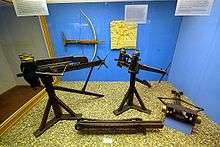Polybolos
Polybolos was an ancient Greek repeating ballista reputedly invented by Dionysius of Alexandria, a 3rd-century BC Greek engineer at the Rhodes arsenal,[1][2] and used in antiquity. Philo of Byzantium encountered and described the polybolos, a catapult that like a modern machine gun could fire again and again without a need to reload.[3] Philo left a detailed description of the gears that powered its chain drive, the oldest known application of such a mechanism,[1] and that placed bolt after bolt into its firing slot.
Mechanism

The polybolos would have differed from an ordinary ballista in that it had a wooden magazine over the mensa (the cradle that holds the bolt prior to firing) capable of holding several dozen bolts. The mechanism is unique in that it is driven by a flat-link chain connected to a windlass; the flat-link chain is an invention more often attributed to Leonardo da Vinci.
When loading a new bolt, the windlass is rotated counter-clockwise with the trigger claw raised; this drives the mensa forward towards the bow string, where a metal lug pushes the trigger under the trigger claw, which is closed over the string.
Once the string is locked into the trigger mechanism, the windlass is then rotated clockwise, drawing the mensa back, drawing the bow string with it.
A round wooden pole in the bottom of the magazine is rotated down toward the mensa as it is drawn to the back of the polybolos, dropping a single bolt into the tray, ready to be fired. As the mensa is twisted farther back, it meets another lug like the one that locked the string into position. This one pushes the trigger and automatically fires the polybolos, and the process is repeated. The repetition provides the weapon's name, in Greek "πολυβόλος", "throwing many missiles",[4] from "πολύς" (polys), "multiple, many"[5] and -βόλος – -bolos "thrower", in turn from "βάλλω" (ballo), "to throw, to hurl",[6] literally a repeating weapon.
Replicas
In 2010 a reconstruction was built by the crew of MythBusters, who concluded that it was a possible weapon. However, the machine MythBusters built was prone to breakdowns.[7]
See also
- Repeating crossbow
- Chain gun, a conceptually similar modern weapon
References
- 1 2 Werner Soedel, Vernard Foley (March 1979). "Ancient Catapults". Scientific American. 240 (3): 124–125.
- ↑ Alan Wilkins (2003). Roman Artillery. Osprey Publishing. p. 8. ISBN 978-0-7478-0575-5.
- ↑ Philo of Byzantium, "Belopoeica", 73.34
- ↑ πολυβόλος, Henry George Liddell, Robert Scott, A Greek-English Lexicon, on Perseus Digital Library
- ↑ πολύς, Henry George Liddell, Robert Scott, A Greek-English Lexicon, on Perseus Digital Library
- ↑ βάλλω, Henry George Liddell, Robert Scott, A Greek-English Lexicon, on Perseus Digital Library
- ↑ Episode 152: Arrow Machine Gun. mythbustersresults.com, November 3, 2010.
External links
![]() Media related to Polybolos at Wikimedia Commons
Media related to Polybolos at Wikimedia Commons